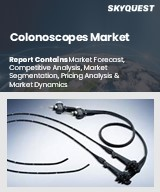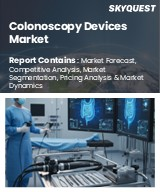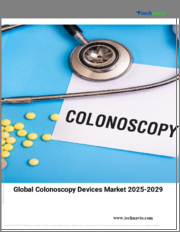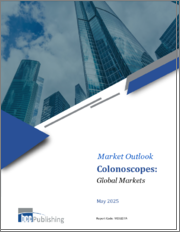
|
시장보고서
상품코드
1764771
대장 내시경 시장(2025-2032년) : 유형별, 처치 유형별, 연령층별, 용도별, 최종 용도별, 지역별 규모, 점유율 및 성장 분석과 산업 예측Colonoscopes Market Size, Share, and Growth Analysis, By Type (Video Colonoscopes Devices, Fiber Optic Colonoscopes), By Procedure Type (Diagnostic, Therapeutic), By Age Group, By Application, By End Use, By Region - Industry Forecast 2025-2032 |
||||||
대장 내시경 세계 시장 규모는 2023년에 26억 달러로 평가되었고, 2024년 28억 2,000만 달러에서 2032년에는 54억 2,000만 달러로 성장할 전망이며 예측기간(2025-2032년)의 CAGR은 8.5%로 예상됩니다.
세계의 대장 내시경 시장은 대장암의 유병률 상승과 조기 진단 및 예방 헬스케어에 대한 의식의 고조에 견인되어 꾸준한 성장을 이루고 있습니다. 또한 이전 보다 진단 정밀도가 대폭 향상되고 있어 시장 수요에 박차를 가하고 있습니다. 그리고 세계 인구의 고령화와 저침습 처치 채용 증가가 헬스케어 시설 전체에 있어서의 대장 내시경 검사 기기의 이용률 상승에 기여하고 있으며 특히 아시아태평양과 라틴아메리카의 신흥 시장은 건강 관리 인프라와 스크리닝 이니셔티브의 개선으로 유리한 기회를 제시합니다. 또한 인공지능과의 통합은 진단 효율을 획기적으로 개선하여 시장에서 보다 역동적이고 혁신을 중시하는 동향을 창출하고 있습니다.
목차
소개
- 조사 목적
- 조사 범위
- 정의
조사 방법
- 정보 수집
- 2차 및 1차 데이터 방법
- 시장 규모 예측
- 시장의 전제조건과 제한
주요 요약
- 세계 시장 전망
- 공급과 수요 동향 분석
- 부문별 기회 분석
시장 역학과 전망
- 시장 개요
- 시장 규모
- 시장 역학
- 성장 촉진요인과 기회
- 성장 억제요인과 과제
- Porter's Five Forces 분석
주요 시장 인사이트
- 주요 성공요인
- 경쟁도
- 주요 투자 기회
- 시장 생태계
- 시장의 매력 지수(2024년)
- PESTEL 분석
- 거시경제지표
- 밸류체인 분석
- 가격 분석
- 규제 분석
- 기술 분석
- 사례 연구
- 고객 구매행동 분석
대장 내시경 시장 규모 : 유형별&CAGR(2025-2032년)
- 시장 개요
- 비디오 대장 내시경 기기
- 광섬유 대장 내시경
대장 내시경 시장 규모 : 처치 유형별 &CAGR(2025-2032년)
- 시장 개요
- 진단
- 치료
대장내시경 시장 규모 : 연령층별&CAGR(2025-2032년)
- 시장 개요
- 성인
- 소아
대장 내시경 시장 규모 : 용도별&CAGR(2025-2032년)
- 시장 개요
- 대장암
- 궤양성 대장염
- 크론병
- 폴립
- 린치 증후군
- 기타
대장 내시경 시장 규모 : 최종 용도별 &CAGR(2025-2032년)
- 시장 개요
- 병원 및 의원
- 외래수술센터(ASC)
- 기타
대장 내시경 시장 규모 : 지역별 &CAGR(2025-2032년)
- 북미
- 미국
- 캐나다
- 유럽
- 독일
- 스페인
- 프랑스
- 영국
- 이탈리아
- 기타 유럽
- 아시아태평양
- 중국
- 인도
- 일본
- 한국
- 기타 아시아태평양
- 라틴아메리카
- 브라질
- 기타 라틴아메리카
- 중동 및 아프리카
- GCC 국가
- 남아프리카
- 기타 중동 및 아프리카
경쟁 정보
- 상위 5개사 비교
- 주요 기업의 시장 포지셔닝(2024년)
- 주요 시장 기업이 채용한 전략
- 최근 시장 동향
- 기업의 시장 점유율 분석(2024년)
- 주요 기업의 기업 프로파일
- 기업의 상세
- 제품 포트폴리오 분석
- 기업의 부문별 점유율 분석
- 전년 대비 수익 비교(2022-2024년)
주요 기업 프로파일
- FUJIFILM Holdings Corporation
- KARL STORZ
- Olympus Corporation
- Endomed Systems GmbH
- Boston Scientific Corporation
- Avantis Group
- HOYA Corporation
- Getinge AB
- SonoScape Medical Corp.
- Endo Technologies
- Smart Medical Systems Ltd
- GI-View
- STERIS
- Stryker
- ESS Inc.
- Absolute Medical
- Medical Recovery Company Inc.
- Pro Scope Systems
- Endo Technologies
- MedWrench
결론과 권고
CSM 25.07.15Global Colonoscopes Market size was valued at USD 2.6 billion in 2023 and is poised to grow from USD 2.82 billion in 2024 to USD 5.42 billion by 2032, growing at a CAGR of 8.5% during the forecast period (2025-2032).
The Global Colonoscopes Market is witnessing steady growth, driven by the rising prevalence of colorectal cancer and growing awareness about early diagnosis and preventive healthcare. Advancements in imaging technology, such as high-definition and 3D visualization, are significantly enhancing diagnostic accuracy, fueling market demand. Additionally, the aging global population and increasing adoption of minimally invasive procedures are contributing to the rising utilization of colonoscopy devices across healthcare facilities. Emerging markets, particularly in Asia-Pacific and Latin America, present lucrative opportunities due to improving healthcare infrastructure and screening initiatives. Furthermore, integration of artificial intelligence in colonoscopy procedures is transforming diagnostic efficiency, making the market more dynamic and innovation-focused. Overall, the market is poised for consistent growth over the forecast period.
Top-down and bottom-up approaches were used to estimate and validate the size of the Global Colonoscopes market and to estimate the size of various other dependent submarkets. The research methodology used to estimate the market size includes the following details: The key players in the market were identified through secondary research, and their market shares in the respective regions were determined through primary and secondary research. This entire procedure includes the study of the annual and financial reports of the top market players and extensive interviews for key insights from industry leaders such as CEOs, VPs, directors, and marketing executives. All percentage shares split, and breakdowns were determined using secondary sources and verified through Primary sources. All possible parameters that affect the markets covered in this research study have been accounted for, viewed in extensive detail, verified through primary research, and analyzed to get the final quantitative and qualitative data.
Global Colonoscopes Market Segments Analysis
Global Colonoscopes Market is segmented by Type, Procedure Type, Age Group, Application, End Use and region. Based on Type, the market is segmented into Video Colonoscopes Devices and Fiber Optic Colonoscopes. Based on Procedure Type, the market is segmented into Diagnostic and Therapeutic. Based on Age Group, the market is segmented into Adult and Pediatric. Based on Application, the market is segmented into Colorectal Cancer, Ulcerative Colitis, Crohn's Disease, Polyps, Lynch Syndrome and Others. Based on End Use, the market is segmented into Hospitals & Clinics, Ambulatory Surgical Centers and Others. Based on region, the market is segmented into North America, Europe, Asia Pacific, Latin America and Middle East & Africa.
Driver of the Global Colonoscopes Market
The global colonoscopes market is significantly driven by the escalating incidence of colorectal disorders, especially inflammatory bowel disease and colorectal cancer. As these health issues continue to rise, there is an increasing emphasis on early detection and regular screening, leading healthcare professionals to recommend routine colonoscopy procedures. This growing trend generates a heightened demand for advanced colonoscopy technologies and equipment, as timely intervention through colonoscopes can greatly improve patient prognosis and survival rates. Consequently, the combination of rising disease prevalence and the critical need for effective diagnostic tools acts as a major catalyst for the expansion of the colonoscopes market.
Restraints in the Global Colonoscopes Market
The global colonoscopes market faces significant restrictions primarily due to high costs, which create financial obstacles that deter many individuals from undergoing this essential screening procedure. The expenses associated with out-of-pocket payments, insufficient insurance coverage, and additional costs for necessary bowel preparation can make colonoscopy unaffordable for a considerable portion of the population, despite medical professionals advocating for its importance. These financial barriers often lead to decreased screening rates, delayed diagnoses, and limited access to vital preventative care, ultimately compromising public health outcomes. Addressing these cost-related issues is crucial for increasing the accessibility and utilization of colonoscopy procedures worldwide.
Market Trends of the Global Colonoscopes Market
The Global Colonoscopes market is witnessing a transformative trend driven by the integration of artificial intelligence (AI) in diagnostics. AI-based systems are increasingly being adopted to enhance the detection and differentiation of colorectal polyps during colonoscopy procedures. These innovations enable clinicians to conduct real-time analysis, significantly improving diagnostic accuracy and facilitating earlier detection of potential health issues. As a result, colonoscopy procedures are becoming more efficient, reducing patient wait times and enhancing overall accessibility. This trend not only boosts diagnostic capabilities but also elevates patient care standards, positioning AI as a pivotal component in the future of gastrointestinal healthcare.
Table of Contents
Introduction
- Objectives of the Study
- Scope of the Report
- Definitions
Research Methodology
- Information Procurement
- Secondary & Primary Data Methods
- Market Size Estimation
- Market Assumptions & Limitations
Executive Summary
- Global Market Outlook
- Supply & Demand Trend Analysis
- Segmental Opportunity Analysis
Market Dynamics & Outlook
- Market Overview
- Market Size
- Market Dynamics
- Drivers & Opportunities
- Restraints & Challenges
- Porters Analysis
- Competitive rivalry
- Threat of substitute
- Bargaining power of buyers
- Threat of new entrants
- Bargaining power of suppliers
Key Market Insights
- Key Success Factors
- Degree of Competition
- Top Investment Pockets
- Market Ecosystem
- Market Attractiveness Index, 2024
- PESTEL Analysis
- Macro-Economic Indicators
- Value Chain Analysis
- Pricing Analysis
- Regulatory Analysis
- Technology Analysis
- Case Studies
- Customer Buying Behavior Analysis
Global Colonoscopes Market Size by Type & CAGR (2025-2032)
- Market Overview
- Video Colonoscopes Devices
- Fiber Optic Colonoscopes
Global Colonoscopes Market Size by Procedure Type & CAGR (2025-2032)
- Market Overview
- Diagnostic
- Therapeutic
Global Colonoscopes Market Size by Age Group & CAGR (2025-2032)
- Market Overview
- Adult
- Pediatric
Global Colonoscopes Market Size by Application & CAGR (2025-2032)
- Market Overview
- Colorectal Cancer
- Ulcerative Colitis
- Crohn's Disease
- Polyps
- Lynch Syndrome
- Others
Global Colonoscopes Market Size by End Use & CAGR (2025-2032)
- Market Overview
- Hospitals & Clinics
- Ambulatory Surgical Centers
- Others
Global Colonoscopes Market Size & CAGR (2025-2032)
- North America (Type, Procedure Type, Age Group, Application, End Use)
- US
- Canada
- Europe (Type, Procedure Type, Age Group, Application, End Use)
- Germany
- Spain
- France
- UK
- Italy
- Rest of Europe
- Asia Pacific (Type, Procedure Type, Age Group, Application, End Use)
- China
- India
- Japan
- South Korea
- Rest of Asia-Pacific
- Latin America (Type, Procedure Type, Age Group, Application, End Use)
- Brazil
- Rest of Latin America
- Middle East & Africa (Type, Procedure Type, Age Group, Application, End Use)
- GCC Countries
- South Africa
- Rest of Middle East & Africa
Competitive Intelligence
- Top 5 Player Comparison
- Market Positioning of Key Players, 2024
- Strategies Adopted by Key Market Players
- Recent Developments in the Market
- Company Market Share Analysis, 2024
- Company Profiles of All Key Players
- Company Details
- Product Portfolio Analysis
- Company's Segmental Share Analysis
- Revenue Y-O-Y Comparison (2022-2024)
Key Company Profiles
- FUJIFILM Holdings Corporation
- Company Overview
- Business Segment Overview
- Financial Updates
- Key Developments
- KARL STORZ
- Company Overview
- Business Segment Overview
- Financial Updates
- Key Developments
- Olympus Corporation
- Company Overview
- Business Segment Overview
- Financial Updates
- Key Developments
- Endomed Systems GmbH
- Company Overview
- Business Segment Overview
- Financial Updates
- Key Developments
- Boston Scientific Corporation
- Company Overview
- Business Segment Overview
- Financial Updates
- Key Developments
- Avantis Group
- Company Overview
- Business Segment Overview
- Financial Updates
- Key Developments
- HOYA Corporation
- Company Overview
- Business Segment Overview
- Financial Updates
- Key Developments
- Getinge AB
- Company Overview
- Business Segment Overview
- Financial Updates
- Key Developments
- SonoScape Medical Corp.
- Company Overview
- Business Segment Overview
- Financial Updates
- Key Developments
- Endo Technologies
- Company Overview
- Business Segment Overview
- Financial Updates
- Key Developments
- Smart Medical Systems Ltd
- Company Overview
- Business Segment Overview
- Financial Updates
- Key Developments
- GI-View
- Company Overview
- Business Segment Overview
- Financial Updates
- Key Developments
- STERIS
- Company Overview
- Business Segment Overview
- Financial Updates
- Key Developments
- Stryker
- Company Overview
- Business Segment Overview
- Financial Updates
- Key Developments
- ESS Inc.
- Company Overview
- Business Segment Overview
- Financial Updates
- Key Developments
- Absolute Medical
- Company Overview
- Business Segment Overview
- Financial Updates
- Key Developments
- Medical Recovery Company Inc.
- Company Overview
- Business Segment Overview
- Financial Updates
- Key Developments
- Pro Scope Systems
- Company Overview
- Business Segment Overview
- Financial Updates
- Key Developments
- Endo Technologies
- Company Overview
- Business Segment Overview
- Financial Updates
- Key Developments
- MedWrench
- Company Overview
- Business Segment Overview
- Financial Updates
- Key Developments



















